Wang Chiu-chiang
Wang Chiu-chiang (Chinese: 王久江; pinyin: Wáng Jiǔjiāng; Zhuyin Fuhao: ㄨㄤˊ ㄐㄧㄡˇ ㄐㄧㄤ; pronounced /ˈwæŋ tʃiuˈtʃæŋ/; born 1957 in Santai, Mianyang, Sichuan), also known as 王九江 (Wang Jiujiang), is a Sichuanese painter whose work is mostly based on the landscapes of Sichuan and Tibet, by reinterpreting the traditional shan-shui style. He is classified as a member of national first-class artists.[1]
Wang Chiu-chiang | |
|---|---|
王久江 | |
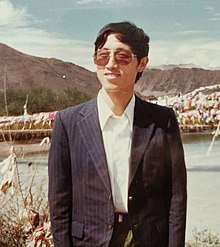 Wang in 1983, in Tibet. | |
| Born | 1957 (age 62–63) |
| Nationality | Chinese |
| Known for | Painting |
| Style | Shanshui |
| Home town | Mianyang |
| Movement | Neo-shanshui |
| Awards | Excellence Award of China Artists Association |
Career
.jpg)
Wang lived in Tibet in the 1980s, where he worked as an art director for the military district of Tibet. In 1982, he created the illustrations for two picture books recounting the Tibetan folklores, The Story of Akhu Tönpa and The Swan. The latter won a second prize in the Exhibition of Fine Arts of the Tibet Autonomous Region.[1] In 1986, with The Eternity, a wood carving painting, he was awarded the Creative Excellence Award in the fifth Exhibition of Fine Arts of Tibet;[2] and several of his sketches were published in the Tibetan newspaper Lhasa Evening, in the same year.[3]
His work The Celestial Burial won the Prize of Honour in the National Competition of Genre Painting in 1988; and Autumn Melody in the Mountains of Aba won a third prize in the Great Contest of Chinese Paintings held in Shenzhen, in 1989.[4] His work High Autumn, for which he received an award of excellence in 1993, has been accepted and accessioned into the collection of the Sichuan Academy of Poetry, Calligraphy, and Painting.[1] In 2002, The Golden Plateau, a shan-shui style painting, was exhibited at the National Exhibition of Chinese Paintings.[5]
In 2003, he was awarded for the work Sutra-chanting (aka Praying, 220 cm × 126 cm)—a 'neo-shanshui' style painting—with the Excellence Award from China Artists Association, while on display in the National Exhibition of Chinese Paintings on West China Scenery.[6][7]
In 2018, Cloud-wrapped Mountains over the Tieh-hsi Lake, a painting made in a relatively more traditional shan-shui style, was presented in the first Exhibition of Fine Arts of Mianyang.[8] He also participates each year in the Ink and Wash Fucheng Invitational Art Exhibition, an annual exhibition held in Fucheng District, Mianyang.[9][10][11]
In addition to shan-shui paintings, he also created gouaches, oil paintings, and some abstract expressionist works during his years as a young adult. And he is also an antique collector.[4]
Critique
Zhang Shiying, a professional painter from Canton, when speaking of the artworks of Wang, stating: 'A sensation of freshness, due to the spacious view and free spirit; a sensation of brightness, due to the absence of desolation and melancholy'.[12]
Gallery
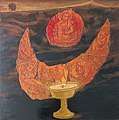 The Eternity
The Eternity Sutra-chanting
Sutra-chanting Great River Canyon
Great River Canyon Mountains in Lung-nan
Mountains in Lung-nan Homeland of the Hawks
Homeland of the Hawks Tibetan Landscape No. 3
Tibetan Landscape No. 3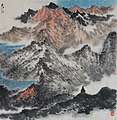 Tibetan Landscape No. 4
Tibetan Landscape No. 4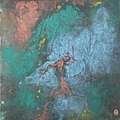 Echoes of the Han-dynasty Melody
Echoes of the Han-dynasty Melody Ancient Totem
Ancient Totem Replica of a fresco of a Buddhist figure of the Mo-kao Grottoes
Replica of a fresco of a Buddhist figure of the Mo-kao Grottoes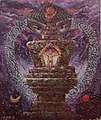 Birth of the Buddha, oil on paper, photograph
Birth of the Buddha, oil on paper, photograph Moonlit Night, gouache, black-and-white photo
Moonlit Night, gouache, black-and-white photo
References
- "王久江 · 国家一级美术师" [Wang Chiu-chiang, the National First-class Artist]. news.tianyancha.com (in Chinese). 24 October 2019. Retrieved 7 May 2020.
- Han, Shuli (1 October 1986). "全区五届美展获奖作品目录" [List of Award-winning Works of Art at the Fifth Exhibition of Fine Arts of Tibet]. Lhasa Evening (in Chinese). Lhasa. p. 4.
- Han, Shuli (8 February 1986). "逻娑画廊" [Lo-so Gallery]. Lhasa Evening (in Chinese). Lhasa. p. 4.
- "王九江" [Wang Chiu-chiang]. zwbk.org (in Chinese). Chinese Encyclopaedia Online. Retrieved 7 May 2020.
- Yang, Jiayong, ed. (2002). 2002年全国中国画作品展 [2002 National Exhibition of Chinese Paintings] (in Chinese). Hefei: Anhui Fine Arts Publishing House. p. 250. ISBN 9787539810270.
- Zou, Yue (13 April 2003). "有花自然香 不用大风扬——记全国美协"中国画大展"获奖者王久江" [Wang Chiu-chiang, the Award-winning artist in the 'Great Exhibition of Chinese Paintings' organised by China Artists Association]. Mianyang Daily (in Chinese). Mianyang. p. 3.
- Liu, Dawei, ed. (2003). 中国西部大地情中国画大展作品集 [Collection of the National Chinese Painting Exhibition on West China Scenery] (in Chinese). Peking: China Artists Association. p. 66.
- "首届绵阳市美术作品展于2018年2月27日在四川文化艺术学院王蒙文学艺术馆开幕". sohu.com (in Chinese). 20 December 2017. Retrieved 7 May 2020.
- Zhang, Dengjun; Guo, Ruoxue (15 January 2019). "本周,到绵阳美术馆免费看名家书画作品". sohu.com (in Chinese). Retrieved 7 May 2020.
- Tang, Yu (12 January 2017). "68幅精品助力绵阳"水墨涪城"名家书画作品邀请展". jyzzxxx.com (in Chinese). Retrieved 7 May 2020.
- Zhang, Dengjun (14 January 2016). ""水墨涪城"今起看名家作品展". su-long.com (in Chinese). Retrieved 7 May 2020.
- Zhang, Shiying (1994). "观《'93四川中国画系列展》" [Review of the Artworks Exhibited at the 1993 Sichuan Exhibition of Chinese Paintings]. In Dai, Wei (ed.). 书画家:’94四川省诗书画院 [Calligraphers and Painters: Sichuan Academy of Poetry, Calligraphy, and Painting] (in Chinese). Chengdu: Sichuan Fine Arts Publishing House. p. 34. ISBN 9787541009402.
External links
| Wikimedia Commons has media related to Wang Chiu-chiang. |